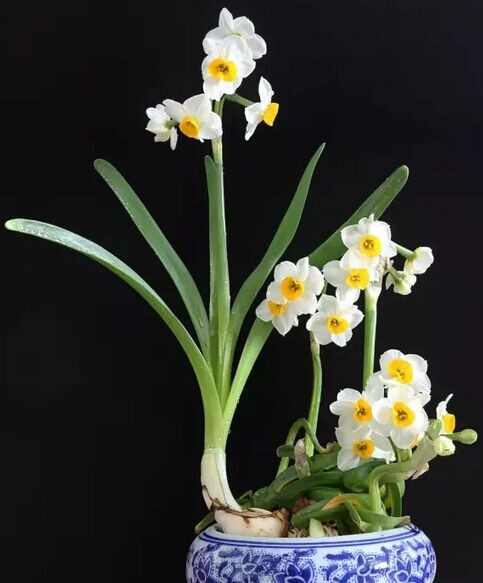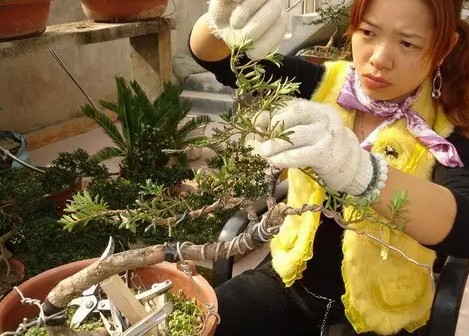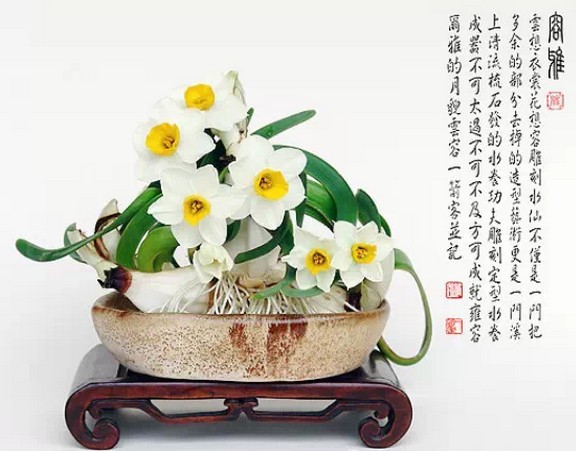Modeling and carving techniques of daffodils bonsai
The choice of flower head is more strict. According to the appearance of the flower head and the author's intention, after careful conception, ingenious efforts, carved layout, careful water culture and gradual trimming, that is, to cultivate into a variety of daffodil bonsai, full of vitality. The carved flower head should be soaked in water for 1-2 days before being raised in water, so that it can fully absorb water, sprout the bud and root tip, and discard the wound to discharge mucus to keep the scales white.

Water culture in addition to the penholder type positive water culture, modeling sculpture shaped water culture, the rest of the use of inverted water culture, that is, the trauma face up. In the early stage of water culture (5 days to 7 days), the leaves and branches are yellow and weak, which should be protected from the sun and should be cultivated indoors. When the leaves turn green, they need enough sunlight to make the plants short, healthy and green. After carving, the flowers will bloom earlier and the tips will be short. It generally blossoms in 25-30 days in the south and colder in the north. It blossoms in 35-40 days and the flowering period is 10-15 days. The flowering period can be adjusted by water temperature, earlier with warm water florescence, and vice versa. If mastered well, it can blossom at the right time.
1. Purification:
Before carving, peel off the outer skin of the bulb and remove the root mud, village roots and rotten impurities, so as to prevent the water-raised scales or roots from being contaminated and moldy.
2. Open the cover:
Use the knife from the scale curved to the bud, pinch the bulb in the left hand, hold the traditional carving knife in the right hand, draw an arc along the distance of about one centimeter from the root disk, and cut off the scales on the surface toward the end of the ball, so that all the buds are exposed.
3. Gap:
Remove the scales sandwiched between the buds so that there is a gap between the buds to facilitate the carving of bud bracts, leaves and pedicels. One is to use the tip of a traditional carving knife to cut through the seams, which is suitable for more skilled sculptors.
4. Peeling:
Peel off the bud bracts exposed to the outside, and the number of bud bracts should be determined according to the modeling requirements. Generally, the oblique knife tip is used to draw two straight lines on both sides of the bud bract, and then use the knife tip to move the bract from the end of the bud toward the base of the bract to prevent bud damage.
Another method is to use an oblique dual-purpose knife, which is more suitable for beginners.
5. Cutting leaves:
According to the modeling requirements, to determine the width of the blade, first use an oblique knife to cut a cut at the end of the blade, and then use a round knife with a round tip to cut along the vein from the end of the leaf to the base. Because the structure of the round knife is that the outer arc of the edge has a certain slope, it is not only easy to cut off the blade, but also avoid damaging the bud. If the blade needs to be cut to the leaf base, a pointed triangular knife can be used to insert the leaf vein to the base.
6. Scraping stem:
According to the modeling requirements, determine the component and orientation of the curette epidermis, and use a bevel knife to scrape off the epidermis from the pedicel end along the pedicel base direction. The base needs to be scraped to the bulb, you can use a pointed triangular knife along the pedicel epidermis to insert into the bulb, you must pay attention to prevent the pedicel from being injured, resulting in dumb flowers or falling flowers.
7. Carved side bulb:
Female bulbs generally bear more than one pair of lateral bulbs, most of which are scapeless, but some of the fleshy lateral bulbs are scapose. Observe carefully when carving lateral bulbs. The lateral scale is not only a part of the whole daffodil ball, but also an indispensable part of the daffodil shape.
8. Trim:
Finally, all the incisions should be trimmed neatly to keep the appearance beautiful and prevent the fragments from mildew. For the bulb to unfold and grow, cut the scales at the bottom regularly. What should be paid special attention to in carving is that because the maturity of flowers and arrows is gradually formed with the passage of time, the scape that controls the flowering of the Spring Festival is relatively mature, and leaves can be cut, scraped and inserted when carving. The phenomenon of damage to bud and drop of bud will be relatively less.
If the flower is controlled to blossom before the Spring Festival, the flower arrow in the bulb when carving is relatively tender, and it is easy to damage the bud and drop the bud when cutting leaves, scraping stems and inserting bases, and the process of cutting leaves, scraping stems and inserting bases will be made up immediately after about a day of dipping the ball. Because at this time, the leaves and arrows begin to loose and detach, and the operation can prevent injury to the bud or falling of the bud. If the ball is soaked for too long, the leaves spread and grow, then the base of the leaves is still fragile, it is difficult to cut the leaves, and it is easy to cause the leaves to break.
Time: 2019-06-13 Click:
- Prev

Bonsai modeling technology of Luohansong
Luohan pine is evergreen in four seasons, with short branches and dense leaves, and its growth rate is slow. The resources of small-leaf tree species are extremely scarce, so using cutting seedlings to produce small bonsai can not only get creative materials, but also help to protect the ecological environment. In the sand bed of seedling raising in greenhouse, Pinus elliottii can use tender wood cuttings.
- Next

The method of cultivating soil daffodils and the method of engraving water culture of daffodils bonsai
Daffodils are not cold-resistant and can be covered in open land for the winter in North China. Like warm winter, cool summer; like moist and sunny enough, resistant to semi-shade; require moist loose and well drained fertile clayey loam, but also resistant to drought and barren. Divide the ball to breed. Plant bulbs in autumn. Like water and fertilizer, need sufficient water and fertilizer during the growing period
Related
- Fuxing push coffee new agricultural production and marketing class: lack of small-scale processing plants
- Jujube rice field leisure farm deep ploughing Yilan for five years to create a space for organic food and play
- Nongyu Farm-A trial of organic papaya for brave women with advanced technology
- Four points for attention in the prevention and control of diseases and insect pests of edible fungi
- How to add nutrient solution to Edible Fungi
- Is there any good way to control edible fungus mites?
- Open Inoculation Technology of Edible Fungi
- Is there any clever way to use fertilizer for edible fungus in winter?
- What agents are used to kill the pathogens of edible fungi in the mushroom shed?
- Rapid drying of Edible Fungi

